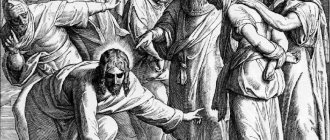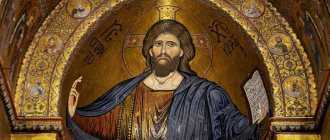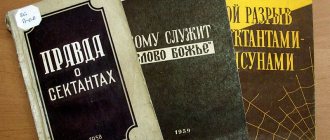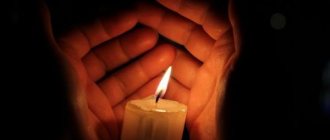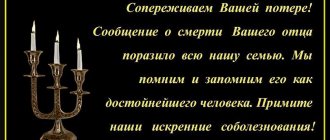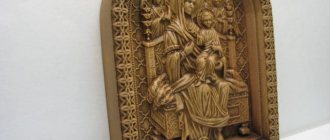Kazan Icon of the Mother of God.
On this day (October 22, Old Style), the Russian Orthodox Church celebrates the Feast of the Most Holy Theotokos in honor of her Kazan Icon.
During the Time of Troubles (late 16th - early 17th centuries), at the call of Saint Hermogenes, the Russian people rose to defend their faith and fatherland - the House of the Most Holy Theotokos.
The Kazan militia had a copy of the Kazan icon, which the soldiers presented to Prince Dmitry Pozharsky. This is what Saint Dmitry of Rostov said in the Word for this day: “The Mother of God delivers from great troubles and evils not only the righteous, but also sinners. But which ones are sinners? You, who return to the Heavenly Father like the prodigal son, those who beat their breasts sigh, like a publican weep at the feet of Christ, like a sinner who has wet His nose with tears, they bring confession to Him like a thief on the cross. The Most Pure Mother of God looks upon such sinners and hastens to help them, and delivers them from great troubles and evils.” Our ancestors always clearly realized that disasters are allowed for sins. The entire people and militia imposed a penitential fast on themselves and fervently prayed to the Lord and His Most Pure Mother,
This was on the eve of the decisive battle for Kitay-Gorod and the Kremlin.
On the night of October 22, the Greek Arseny, who was languishing in captivity with the impostor, arrived in Moscow with the Greek Metropolitan Jeremiah, the Monk Sergius of Radonezh appeared and said: “Arseny, our prayers have been heard: in the morning Moscow will be in the hands of the besiegers and Russia will be saved.”
They managed to convey the good news to the Russian army, and they, calling on the Queen of Heaven for help, took China - the city and the Kremlin - by storm. On October 22 (November 4, New Style), 1612, Moscow was liberated from the Polish invaders.
1 page, 447 words
Description of Rublev’s icon “Trinity”
... from the Divine throne, so there is no shadow on the table. The idea of the icon is to express the teaching of the Orthodox faith about the Trinity, One and Indivisible, to convey the consubstantiality and equality of all three... similar to Golgotha, as a symbol of the atonement for the sin of the first people. In general, the icon is built on the principle of a circle, symbolizing eternity, and with it the infinity of Divine love. Color spectrum …
erected the Kazan Icon of the Mother of God in his parish church in honor of the Entry of the Most Holy Theotokos into the Temple on Lubyanka. Around 1636, the icon was transferred to the Kazan Cathedral on Red Square, built by the prince in gratitude to the Lord and His Most Pure Mother for the salvation of Russia. Now this icon is in the Epiphany Cathedral in Moscow.
The celebration was established in 1649. For many centuries, the Kazan icon has been protecting the country from foreign invaders. In 1709, Peter I prayed before the Kazan Icon.
In 1710, a revered copy of the icon was placed in St. Petersburg (later the Kazan Cathedral was built for it).
A hundred years later I prayed in front of the holy icon.
His prayer was heard: on the day of the celebration of the Kazan Icon, October 22, 1812, Russian troops led by Miloradovich and Platov defeated the rearguards of Marshal Davout - this was the first defeat of Napoleon’s hitherto considered invincible army.
And during the Great Patriotic War, the Kazan Icon protected Russia: the cover of the Most Holy Theotokos was spread over Moscow, over besieged Leningrad; she was in Stalingrad, on the Kursk Bulge; near Koenigsberg.
3..
Nowadays, Russian icons rightfully occupy their place among the masterpieces of world art. Of all the Russian masters, the name of Andrei Rublev covers the greatest fame.
Saint Andrew was born around 1360, as is believed, into a wealthy and noble family. (This, by the way, confirms the presence of the family nickname Rublev, because in those years only representatives of the upper strata had surnames.) From childhood, the boy amazed those around him with his sharp mind, and later many wrote about Rublev’s extraordinary wisdom.
The time in which the Monk Andrew lived was turbulent. In 1380, Rus' won a victory on the Kulikovo field, but two years later Moscow was burned by Tokhtamysh. And in 1395, the hordes of Tamerlane fell on Rus'. These great upheavals undoubtedly influenced Andrei's choice of life path. He became a monk at the Spaso-Andronikov Monastery and began to strive in prayer and fasting. Temples in those years were often destroyed and burned down. Entire iconostases disappeared. The writing of holy icons became the main obedience of the Monk Andrew.
The Metropolitan writes a copy of the Vladimir Icon of the Mother of God, through prayer before which Moscow was delivered from the hordes of Tamerlane. Around 1405, Rublev painted the Annunciation Cathedral in the Moscow Kremlin, and then the Assumption Cathedral in Vladimir - the main churches in Rus'. He paints icons, creates murals and iconostases, works in the Assumption Cathedral in Zvenigorod, in the monastery of Savva Storozhevsky, in the Spaso-Andronikov monastery, in the monastery of St. Sergius. In the middle of the 16th century, the Stoglavy Cathedral elevated its icons to a universal model, ordering the image of the “Trinity” to be painted “as Andrei Rublev wrote.”
In Vladimir, Rublev worked together with another famous icon painter of that time - master Daniil Cherny. Both of them were unmercenary and led a strict life. Close friendship will bind two ascetics until the end of their days. For all centuries, these great masters showed subsequent icon painters an example of true friendship and true holiness.
14 pp., 6620 words
The phenomenon of icons in medieval culture
...as was believed in Rus', he was able to convey in the icon all the immensity and beauty of the speculative world of sacred values. Thus, how ... Rus' organically entered European medieval culture, discarding, however, - in ... The icon (from the Greek “eikon” - image, image) is completely different from an ordinary picture. In the icon... When painting backgrounds of icons and halos around the heads of saints, light colors were used...
Already in the 15th-16th centuries, no one doubted the high righteousness of Daniel and the holiness of Andrew. In the Stroganov icon painting original (late 16th century) Rublev was written about as a saint: “The icon painter of Radonezh, nicknamed Rublev, painted many holy icons, all miraculous.” In miniatures of that time, Rublev was depicted with a halo. The glorification of Saint Andrew took place in 1988, when our country celebrated the millennium of the Baptism of Rus'.
When were icons “legalized”?
However, 33 years later, the participants of the 7th Ecumenical Council in 787 , having canceled this decision, “ordered” through a special canon the veneration of icons without proper explanation of why this was necessary. From that time on, worship of the image of the cross began to be encouraged. But the struggle did not end there.
The Paris Council in 825 again prohibited the veneration of icons. 17 years later, in 842, at the insistence of Empress Theodora, a depraved and immoral woman, the cult of icon worship was finally established, being mandatory in the Western and Eastern churches.
Naturally, the iconoclastic councils were subsequently outlawed and even called “robbery.” A new broom sweeps in a new way...
Bibliography
[Electronic resource]//URL: https://liarte.ru/referat/na-temu-ikona-klass-po-orkse/
1. Archbishop Benjamin (Pushkar) “Sacred History.”
St. Petersburg, Vladivostok, 2006
2.
Textbook “Orthodox Culture of Russia” on CD-ROM. Novosibirsk, 2004
3. “Annunciation” on CD-ROM, Internet site.
4. D. Basov, S. Basov “Icons in the temple and in your home.” A.V.K., 2001
5. Orthodox calendar 2000
Examples of similar educational works
The image of Russia in the anonymous book 'An Englishwoman in Russia'
... written by a citizen of the British Empire in 1854. In Russian literary criticism, the book “An Englishwoman in Russia” is mentioned in the monograph by N.P. Michalskaya “The Image of Russia in English Fiction of the 9th-19th Centuries.” The book is characterized...
The image of Russia in Nabokov's works
... the image of a distant, lost homeland, and the image of a poet who grew up in a foreign land. 1. Blok’s imagery and expressiveness in Nabokov’s poem “Russia” To me ... stanza: Shadow runs after shadow - it won’t catch up, Along the wall... Lie down, don’t grumble. Is the wind moaning? Let it go …
The image of Russia in the poetry of Sergei Yesenin (page 1 of 2)
... the image of Russia in the works of S.A. Yesenin 1920s. 1. The image of Russia in Yesenin’s early lyrics The theme of the Motherland is one of the most important themes... grandfather, sisters: There is a calendar Lenin on the wall, Here is the life of sisters, Sisters, not mine... Yesenin, S.A. Collected works: In 2...
The image of Russia in the lyrics of Alexander Blok
... can be shown Essay: The Theme of Russia in the Works of Blok The theme of the Motherland occupied a very important place in the work of Alexander ... made it a masterpiece. Other topics: ← The image of Rus' in Blok’s poetry↑ Blok ` Popular essays Blooming meadow - essay One of ...
The image of Russia in the comedy The Inspector General by Gogol
... Gogol makes it clear that “incognito from St. Petersburg” checks were a common occurrence in Nikolaev Russia. ... Picture for the essay Image of Russia in the Inspector General Popular topics today There is ... time in the country. This county town reflects the mass of problems that...
General information about icons, their spiritual value
The face depicted on the icon is not the Lord God. It is believed that it is intended only to remind the praying person of the Divine. That’s why they write on the icon not the face, but the face. Very important in him are the eyes, which reflect the depth of the soul. No less significant are the hands, whose gestures carry a certain meaning.
The rest of the figure is very airy, as it is designed to show inner strength. This is exactly what the emphasis is on.
At a certain period of time, a religious theme became popular among artists. And it seems that there is a painting and an icon on the same topic; the same saint is depicted on it, for example. But on the first canvas there is spirituality, but on the second there is none. Therefore, when painting icons, they demand that canons that were written long ago be observed, which exclude random details. Each fragment carries a certain semantic and spiritual meaning.
An icon from a historical perspective
The appearance of icons dates back to the 1st century AD. It is believed that the first of them was created by Luke, who wrote one of the parts of the Gospel. According to the second version, the oldest image is the imprint of the face of Jesus Christ when he kissed a towel while washing himself.
One way or another, the oldest images found were dated to the 6th century. They were made in the Byzantine Empire, which had a great influence on the painting of icons. In it, but much later, canons for painting images were written.
The history of icons has different periods. There were persecutions, flourishing, and changes in writing style. Each of the images reflects its time, each is unique. There are a lot of icons that exuded myrrh, tears, blood, and healed the sick in difficult times. They are revered as the greatest shrines.
Icon of St. Nicholas the Wonderworker
Nicholas the Wonderworker is an equally revered saint in the Christian world. People turn to him on various issues - from physical illnesses to stopping quarrels and hostilities. He lived in the 3rd-4th centuries and during his lifetime became famous for his great deeds. There are numerous icons of him, photos of which illustrate his spirituality.
The oldest image of the saint dates back to the 11th century and is located on Mount Sinai, in the monastery of St. Catherine.
Today, in many monasteries and temples there are his images that have miraculous properties.
Icons of Sergius of Radonezh
Sergius of Radonezh is one of the most revered saints. During his life he performed many deeds in the name of Christ. His words reconciled and pacified.
On the icon, Sergius of Radonezh is depicted stern, with his right hand raised in blessing. In his left he holds a scroll as a symbol of knowledge. His icons and their meaning are very important for Christians. They pray to this saint for protection from enemies for the country. It also helps in studying, before an exam, or simply during times of difficulty in understanding something.
Icons of the Son of God Jesus Christ
One of the first images of Jesus Christ was his imprint on a towel, which miraculously appeared there. In the modern world it is called the Savior Not Made by Hands.
If we talk about icons of Jesus Christ, there are a lot of them. There are also several forms of writing his images.
- The Savior is a stern face; its writing does not depart from the canon.
- Savior Almighty - it is believed that this is his main image, which also corresponds to his preaching age.
- Savior Not Made by Hands. It is represented by two types – “Spas on the ubrus” and “Spas on the skull”.
The image of the Son of God now has some essential elements. This is a halo, a book, outerwear, a clave, a chiton. An inscription is also required.
His icons and their meaning have a special status in Christianity.
How icons are created
An icon is an important symbol for a believer, so the process of its creation is reflected in long-described canons that are still preserved. Creating an image is not a quick task; it takes at least three months.
Creating an icon has some stages that are strictly followed:
- Selecting wood and making the board that will serve as the base.
- Then the surface is prepared. This is necessary so that the image is preserved for a long time without changes. To do this, several steps are taken. First, the notches are made, then liquid glue is applied, followed by a primer (gesso). The latter should be applied several times and allowed to dry well, then sanded. Often, pavolok or serpyanka (special fabric) is glued in front of the gesso layer.
- The next stage is drawing. This is not the final image - just an outline. It should then be squeezed out with something sharp so that it does not get lost among other layers.
- If the icon will have gilding, then it should be applied right now, at this stage.
- Now you need to prepare the paints. To paint icons, you need to take natural ones.
- The first paints are applied in one color, on the background and background elements.
- Then comes the painting. The first to process the personal elements (landscape, clothing), after which the personal details (arms, legs, face) are painted. They also sign the icon (who is depicted on it).
- The final touch is treatment with drying oil or varnish.
Then the icon must be consecrated.
Prices for icons
You can buy icons in every church shop. Their prices may vary. The most expensive, of course, are the ancient images that have survived to this day. Many of them are kept in museums or temples. Such icons are usually not sold, only appraised. For example, the images of the Apostles Peter, Paul, John, and Mark date back to the 16th century. They are valued at 150 thousand euros.
Also, the cost of the icon will depend on its design. After all, even images painted in our time, but decorated with expensive materials (gold, silver, precious stones), will not be sold cheaply. Their price range can start from 2500 rubles. The cost will depend on the materials.
If you need inexpensive icons, then there are icons that are completely simple in design. They can be purchased in shops near the church. Similar images can be purchased at prices ranging from 100 rubles and above.
Rare icons can be purchased in an antique shop or during the sale of a private collection. It is difficult to overestimate such icons and their significance, since for a believer they are truly priceless.


